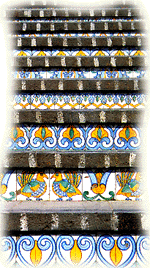 |


|
|
FROM THE CATANIA PLAIN |
|
| Crossing the Catania plain towards Caltagirone, the route leads through the town of Militello, Vizzini and Grammichele. A stop in the first of these localities is obligatory in order to admire the marvellous "palazzi" and the fine 16th and 17th century fountains, while Vizzini conserves suggestive recollections of Giovanni Verga - who was born here - like the famous Cunziria, where the novelist set the duel of the rustic cavalry. Grammichele, on the other hand, is extremely interesting for its hexagonal urban plan designed by Carlo Maria CarafÓ, Prince of Butera, after the disastrous earthquake of 1963, when the town had to be entirely rebuilt. Finally we reach Caltagirone, a city which would deserve an entire, and perhaps interminable, book to describe it. The town is shaped like an amphitheatre on three hills; the archeological remains and traces of settlements found in the area are evidence of a civilisation which definitely preceeded that of the Greek-Sicilians. Called the Faenza of Sicily, it is enough to visit the town to understand why. Here the art of pottery has achieved incomparable results in every age, as one can see from every street corner, building and fountain. Bongiovanni Vaccaro was born here in 1759: his fame as a potter was such that he was called by the archduke Ferdinand III to decorate the villa at Poggio Imperiale with his works. His brothers Giacomo, Francesco and Giuseppe were equally well known and their works canbe found today in museums the world over. The development of the town's pottery from the prehistoric to the modern age can be traced in Caltagirone's State Pottery Museum, the only institute which records the technical and artistic evolution of this craft. Among contemporary artists, we wish to recall Giuseppe Bonaccorso who is still working today despite his age: his magnificent sacred figures and Christmas cribs can be found in the most important Italian and foreign collections. At Caltagirone it is impossible not be astounded by the great fligh of steps at Santa Maria del Monte: each of the 142 8-metre-wide steps is decorated with colourful ceramics designs, all of them different. Nor should one miss the home of the Ventimiglia potters, another celebration of bright enamel. But there are thousands more monuments telling the splendid history of this town. Artists like Antonello da Messina, Antonio Gagini and Polidoro Caldara da Caravaggio worked here between the 15th and 17th centuries, to be followed in later periods by Rosario Gagliardi, Paolo Amaro, Natale Bonaiuto and G.B. Basile, leaving an artistic heritage of indescribable value and beauty.
|
||


